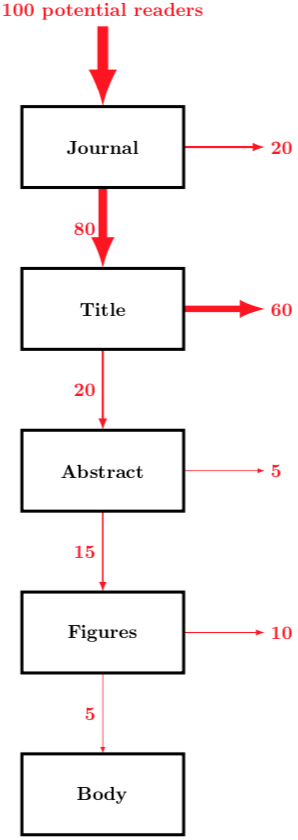I intend this guide for grad students in my engineering research group. Some of the recommendations apply broadly, but others are specific to me or my field.
Why should I publish research papers?
Most researchers hope their work improves the real world in some tangible way. Publishing doesn’t guarantee that, but it helps.
Publishing also students get jobs in academia and research labs, and helps professors get tenure and promotions.
How many papers should I publish?
For most purposes, the more the better.
In my field, professors typically expect one good first-author journal paper for a master’s degree and three for a PhD. Conference papers and non-first-author journal papers usually don’t count.
Who decides whether my paper gets published?
Editors and peer reviewers.
A submitted journal paper goes to an editor, who screens it for perceived quality and relevance to the journal’s scope. If the paper passes that check, the editor sends it to one or more peer reviewers. Reviewers read the paper, or at least skim it, and score its originality, correctness, and impact. Reviewers submit scores to the editor, who decides whether to reject the paper, accept it conditioned on revisions, or accept it as is.
Most conferences work similarly.
What makes a paper publishable?
Publishable papers are papers that editors and reviewers believe are original, correct, and impactful.
Some people think that doing a lot of work entitles them to publication. Others think that papers that are easy to write must be unpublishable. Neither view is accurate.
How do I show originality?
Original papers create new ideas, theorems, methods, algorithms, data, statistics, software, or physical objects. To convince editors and reviewers of originality, authors should (a) show that they understand related work, and (b) state several creations in their paper that don’t exist in related work. Each of those creations is a contribution.
When trying to show originality, authors sometimes dismiss or deride related papers. I don’t recommend this. The authors of those papers may be your reviewers. Also, it’s rude.
How do I show correctness?
In theory, a paper should demonstrate inarguably that its contributions are correct.
In practice, editors and reviewers rarely have time to check this. Instead, they check things they view as stand-ins for correctness. Authors can improve their odds of passing correctness checks by using good grammar, spelling, and logic; showing that they understand related work; clearly explaining all methods; using standard, consistent mathematical notation; defining all symbols; making figures easy to understand; and sharing all data and code necessary to validate their contributions.
How do I show impact?
Explain how the contributions could tangibly improve the real world.
Which individuals, businesses, or government bodies could use the contributions? How could the contributions change behavior, products, or policies? What improvements to the real world could those changes cause? How large could those improvements be? Who could benefit?
For example, suppose you create a control algorithm that improves air conditioner efficiency by 15%. Manufacturers could add your control algorithm to their air conditioners. A typical family could save $75 per year on energy bills. Communities near power plants could breathe less air pollution and suffer less respiratory illness. The world could emit 1% less greenhouse gas pollution, slow climate change slightly, and inflict less suffering on disadvantaged people.
Where should I focus my efforts?
The title, abstract, figures, and statement of contributions.
Few people who interact with your paper will reach the main body of text, as the figure below illustrates. You can increase the number of people who actually read the paper by (a) publishing in a good journal, which increases the number of potential readers; and (b) shaping the title, abstract, and figures to draw in potential readers.

Better journals get more readers. Readers are busy and the world is full of bad papers. Good journals save readers time by filtering out bad papers. Publishing in a good journal requires a convincing statement of contributions; see “How do I show originality?”
My favorite kind of title states the paper’s best contribution in a simple sentence. My least favorite titles use acronyms and jargon. Some good titles ask provocative questions, which the abstracts answer.
A good abstract gives away the whole paper. It tells readers why they should care about the topic, what past work has shown, what contributions the paper makes, and how the contributions could tangibly improve the real world.
Figures should make sense to people who’ve only read the title and abstract. Legends and axis labels should use words, not acronyms or symbols. Text in figures should be about as big as text in the body. Each figure should convey one key message. Any element of a figure that doesn’t help convey the figure’s key message should be cut. Most figures should showcase the paper’s contributions — typically with one or two figures or tables per contribution — but a couple of figures can illustrate the problem or methods.
As I write the body of a paper, I periodically stop and read it out loud. Can I audibly say the words I wrote without confusing myself, cringing at the sound of my own voice, or boring myself to sleep? I find this almost a necessary and sufficient condition for decent writing.
A few style tips:
- Shorten words, sentences, paragraphs, papers. To respect busy readers, get to the point.
- Use mostly active voice (“Fig. 3 shows…”), not passive (“It can be seen from Fig. 3 that…”).
- Delete most adjectives. Let readers decide for themselves if a result is “impressive” or an idea is “innovative.”
- Restrict each paragraph to one main idea, encapsulated in its first sentence.
- Use few or no acronyms. Readers jump around papers; an acronym defined on page three may alienate a reader who jumps from page one to six.
- Spell out the integers zero through nine and any number that starts a sentence. Write all other numbers as numerals (12, -3, 2.718, etc.).